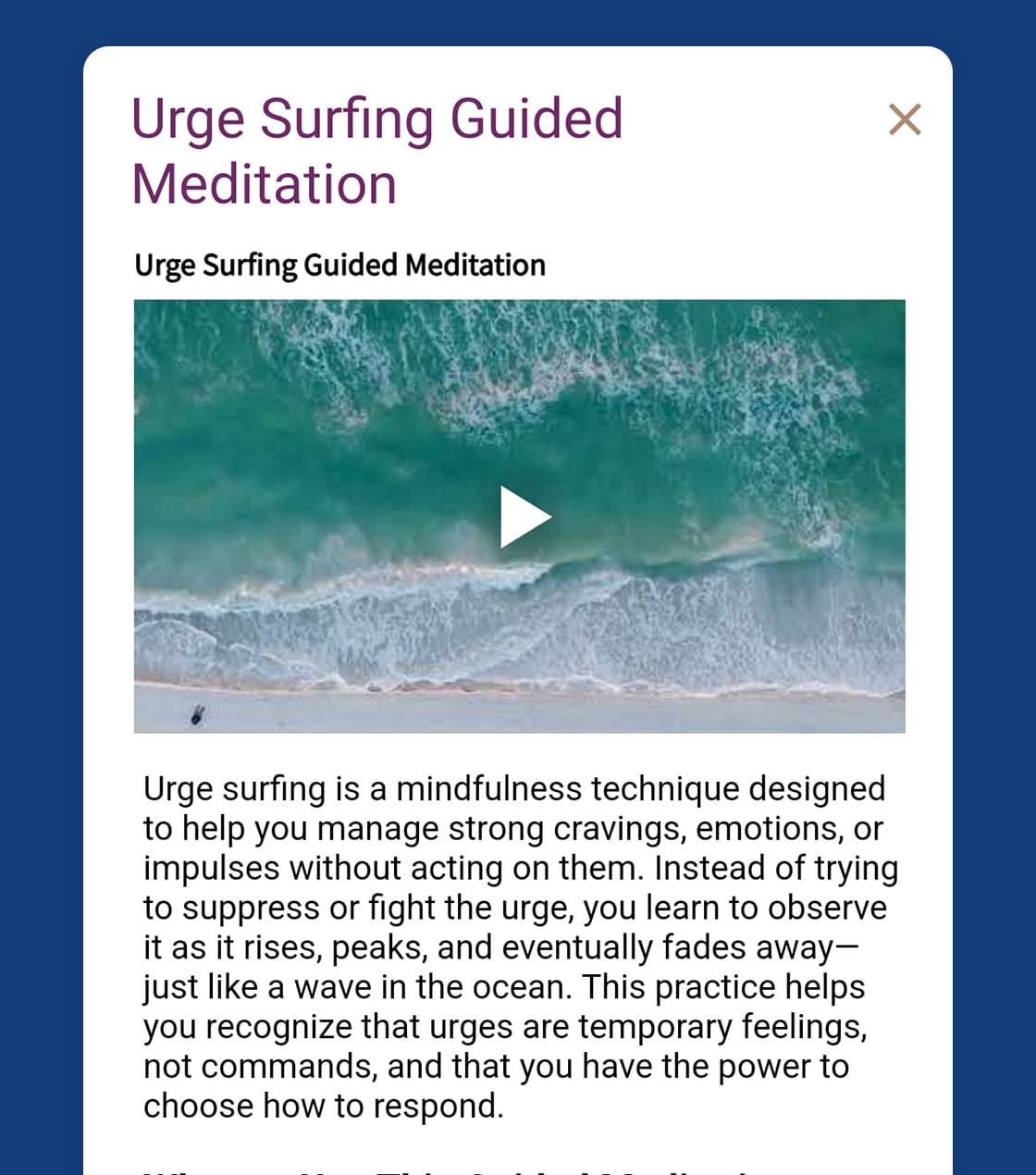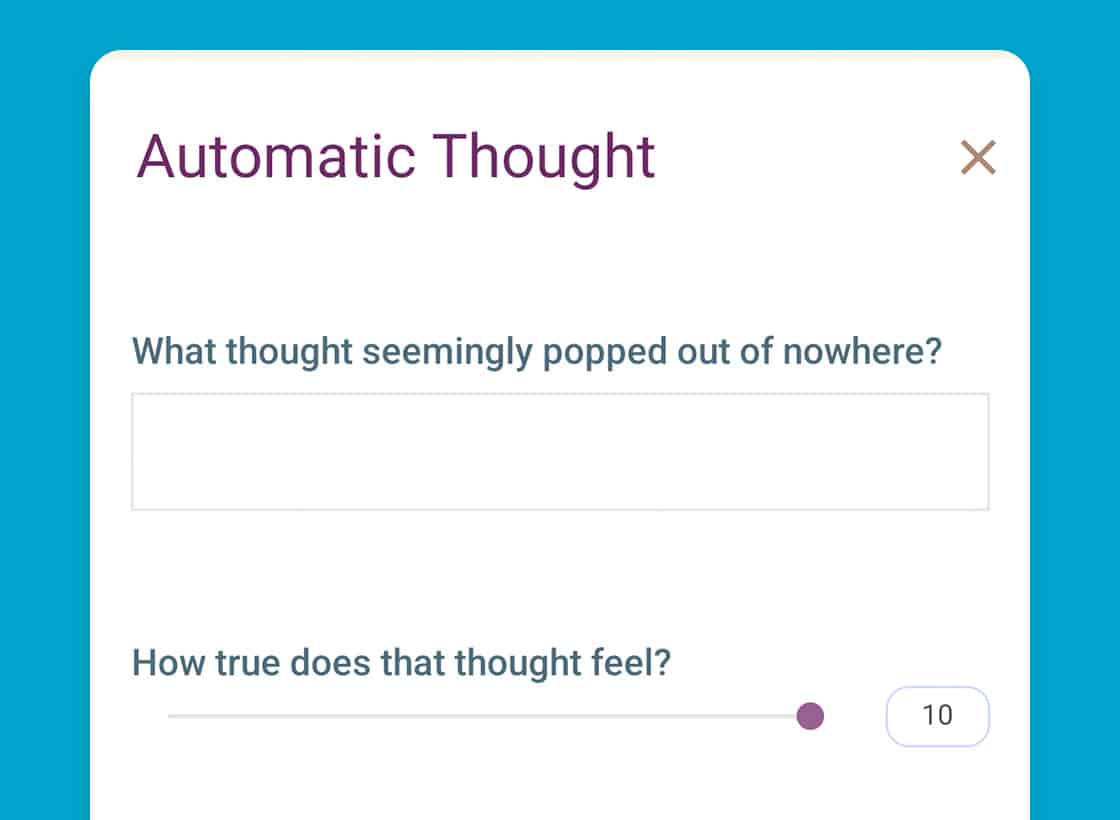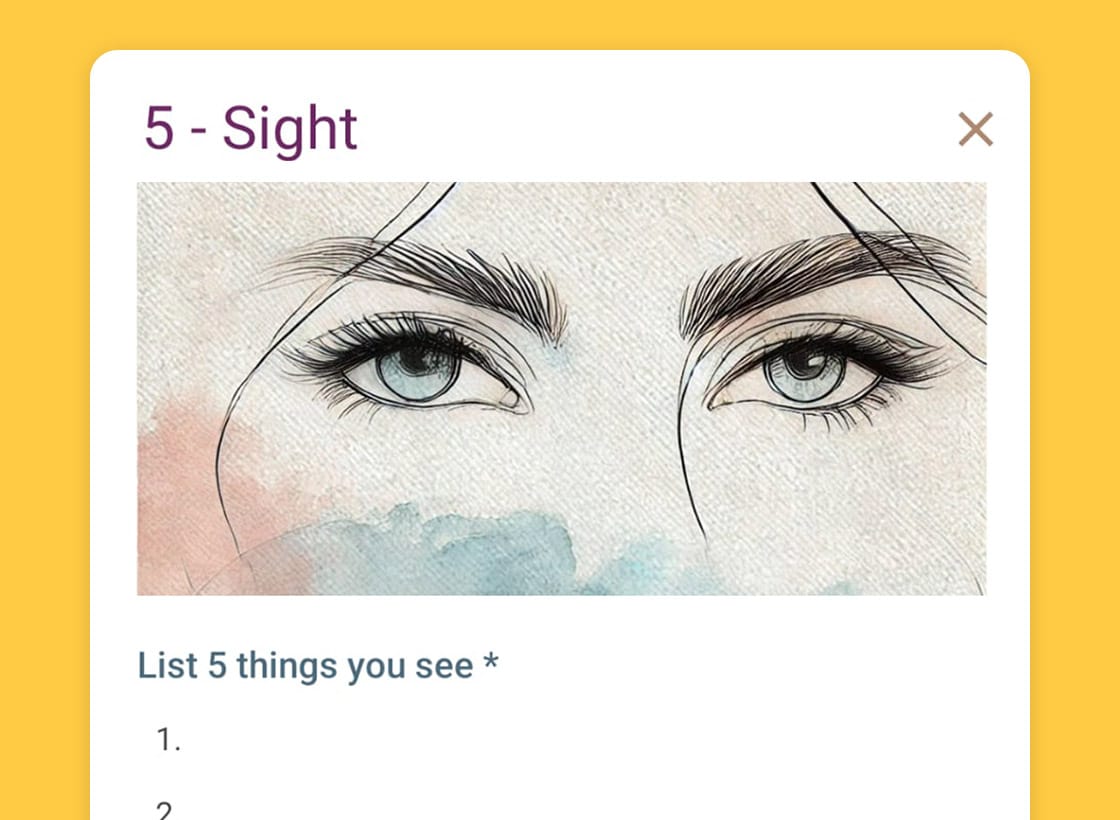Urge Surfing Guided Meditation
Template by Reflective
Best for OCD En Eating Substance Use Addiction Relaxation Mindfulness
The Urge Surfing Guided Meditation is a 10-minute audio tool designed to help clients navigate intense cravings or impulses with mindfulness and self-compassion. This soothing meditation combines breathing exercises and a calming visualization to support clients in staying grounded, present, and detached from their urges. It is particularly effective in Dialectical Behavior Therapy (DBT), Acceptance and Commitment Therapy (ACT), and other mindfulness-based approaches. Ideal for clients struggling with addiction, substance use, emotional eating, or impulse control, this meditation empowers them to observe their urges without acting on them, fostering resilience and self-regulation.
Share the Urge Surfing Guided Meditation with your client
Share the Urge Surfing Guided Meditation tool with your client using the Reflective app so they can practice urge surfing between sessions. Simply enter their email, and they’ll be able to fill in the worksheet from the convenience of their phone. Sign up for a Free trial.
How does Reflective work?
Share exercise with client via Reflective
Client receives email with app link and connection request
Client clicks link to download app
Client accepts your connection and exercises you shared
Client uses app to fill in exercises, gets reminders
Table of Contents
- Introduction
- History of the Urge Surfing Technique
- The Science Behind Urge Surfing
- Teaching Urge Surfing to Clients
- Reflective Practice
- Case Examples and Success Stories
- Closing Thoughts
Introduction to Urge Surfing
Urge surfing is a mindfulness-based technique that empowers clients to navigate intense urges—such as cravings, impulsive desires, or overwhelming emotions—by observing them without acting on them. This skill is particularly effective for clients managing addiction, emotional dysregulation, or impulsivity. Rather than resisting urges (which can intensify them), clients learn to accept and ride out the wave, allowing the urge to naturally subside.
Therapists who integrate urge surfing into their practice can enhance client outcomes in a variety of therapeutic modalities, including Dialectical Behavior Therapy (DBT) and Acceptance and Commitment Therapy (ACT). Tools like Reflective can further strengthen skill acquisition by keeping clients engaged and accountable between sessions.
History of Urge Surfing
Urge surfing originated from the integration of mindfulness techniques into addiction recovery frameworks. Dr. Alan Marlatt, a pioneering researcher in addiction and relapse prevention, developed the concept in the 1990s. Inspired by the mindfulness-based practices popularized by Jon Kabat-Zinn’s Mindfulness-Based Stress Reduction (MBSR) program in the late 1970s, Marlatt applied these principles to help individuals manage cravings and avoid relapse.
Marlatt’s approach, called Mindfulness-Based Relapse Prevention (MBRP), emphasized the importance of observing urges with nonjudgmental awareness. He introduced the wave metaphor to illustrate how urges naturally rise and fall, helping clients recognize that discomfort is temporary and does not require immediate action. This technique has since been widely adopted in therapies such as Dialectical Behavior Therapy (DBT) and Acceptance and Commitment Therapy (ACT), where mindfulness and distress tolerance play key roles.
Key sources for this work include:
- Marlatt, G. A., & Donovan, D. M. (2005). Relapse Prevention: Maintenance Strategies in the Treatment of Addictive Behaviors. The Guilford Press.
- Kabat-Zinn, J. (1990). Full Catastrophe Living: Using the Wisdom of Your Body and Mind to Face Stress, Pain, and Illness. Bantam Books.
- Bowen, S., Chawla, N., & Marlatt, G. A. (2011). Mindfulness-Based Relapse Prevention for Addictive Behaviors: A Clinician’s Guide. The Guilford Press.
Therapists who integrate urge surfing into their practice can enhance client outcomes in a variety of therapeutic modalities, including Dialectical Behavior Therapy (DBT) and Acceptance and Commitment Therapy (ACT). Tools like Reflective can further strengthen skill acquisition by keeping clients engaged and accountable between sessions.
The Science Behind Urge Surfing
The “wave” metaphor in urge surfing reflects the natural ebb and flow of urges. Like waves, urges rise to a peak before gradually diminishing, regardless of whether they are acted upon. This understanding helps clients see that their discomfort is temporary and manageable.
From a neurobiological perspective, urges often stem from the brain’s reward system, driven by dopamine release. Resisting urges outright can trigger heightened craving, creating a cycle of intensifying discomfort. Mindful awareness disrupts this cycle by shifting focus to observing the urge with curiosity rather than judgment. Over time, this practice can reduce the power of urges and increase emotional resilience.
Using Audio-Guided Meditations to Support Urge Surfing
Audio-guided meditations can be a powerful tool for helping clients practice urge surfing, especially between sessions. These meditations provide structured guidance, allowing clients to focus on their breath, visualize urges as waves, and develop mindfulness skills in real time.
Benefits of incorporating audio-guided meditations include:
- Accessibility: Clients can use meditations anytime and anywhere, making it easier to practice urge surfing in high-stress moments.
- Consistency: Regular use reinforces mindfulness techniques and helps clients build a habit of observing their urges without reacting.
- Emotional Regulation: The calming effect of a guided voice and soothing background sounds can help clients stay grounded during intense urges.
Therapists can recommend pre-recorded meditations or create custom recordings tailored to their clients’ needs. For example, Reflective can be used to share meditation links or upload custom audio guides directly into a client’s profile. Prompts such as, “Listen to this 5-minute meditation when you notice a craving arise,” can provide clear, actionable steps for clients.
Including audio-guided meditations in your therapeutic toolbox adds another layer of support, ensuring clients feel equipped to navigate urges independently.
Teaching Urge Surfing to Clients
To help clients master urge surfing, therapists can follow these steps:
- Recognize the Urge Encourage clients to notice the urge as soon as it arises. Awareness is the first step to breaking automatic reactions.
- Name and Describe the Urge Guide clients to describe their experience in detail, including physical sensations (e.g., tightness in the chest) and emotional components (e.g., anxiety or frustration).
- Practice Mindful Breathing Teach clients to use their breath as an anchor to stay present. Slow, deep breathing can help them remain calm and grounded.
- Visualize the Urge as a Wave Clients imagine the urge rising, peaking, and eventually falling, much like a wave. This visualization reinforces the impermanence of their discomfort.
- Allow the Wave to Pass Encourage clients to sit with the urge, observing it without acting on it. Reassure them that even strong urges will fade with time.
Common challenges include clients catastrophizing their discomfort or struggling to maintain mindfulness. Therapists can address these by normalizing the difficulty of the practice and offering compassionate encouragement.
Reinforcing Urge Surfing Between Sessions
Reflective’s tools can amplify the effectiveness of urge surfing by fostering ongoing practice and accountability. Key features include:
- Meditations: Check out the urge surfing script and infosheet explainer about urge surfing which can be added to your client’s weekly practice between sessions.
- Client Reminders: Reflective can send reminders to practice urge surfing during high-risk moments, such as after a stressful day.
- Journaling Prompts: Clients can log their experiences, noticing patterns and triggers associated with their urges. For example, prompts might include:
- “Describe a recent situation where you felt an urge. What happened when you observed it like a wave?”
- “Rate the intensity of your urges over the past week and how successfully you surfed them.”
- Progress Tracking: Therapists can review clients’ entries to identify trends and provide tailored feedback, helping clients refine their technique.
By bridging the gap between sessions, Reflective ensures that urge-surfing practice becomes an integrated part of clients’ daily lives.
Case Examples and Success Stories
Client A: Emotional Eating
Client A struggled with binge eating during moments of stress. Through urge surfing, they learned to identify cravings as they arose, describe their physical sensations, and observe the wave of emotion without acting on it. Using Reflective, they logged their progress and reflected on successful moments, reinforcing their confidence in managing urges.
Client B: Substance Use
Client B struggled with strong urges to use substances during stressful situations. Urge surfing provided them with a mindful approach to observe and ride out these cravings without acting on them. By journaling their experiences in Reflective, they identified specific triggers and patterns, such as social gatherings or moments of loneliness. Their therapist used this information to help them develop personalized strategies to manage high-risk situations and reinforce their progress.
These examples highlight how urge surfing, supported by Reflective, can empower clients to navigate even the most challenging urges.
Closing Thoughts
Urge surfing is a powerful skill that therapists can use to help clients manage impulses and emotions. By teaching clients to “ride the wave,” therapists equip them with a lifelong tool for resilience and self-regulation.
Reflective complements this work by extending therapeutic support beyond the session, helping clients practice and refine their skills in real time. To see how Reflective can elevate your practice and enhance client engagement, start using it with your clients today.



